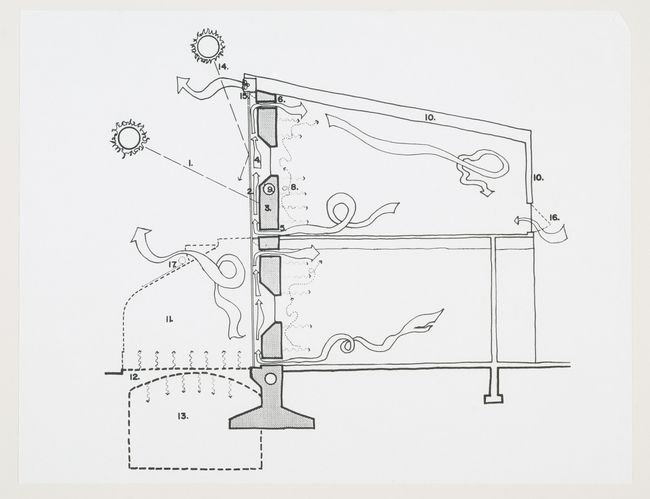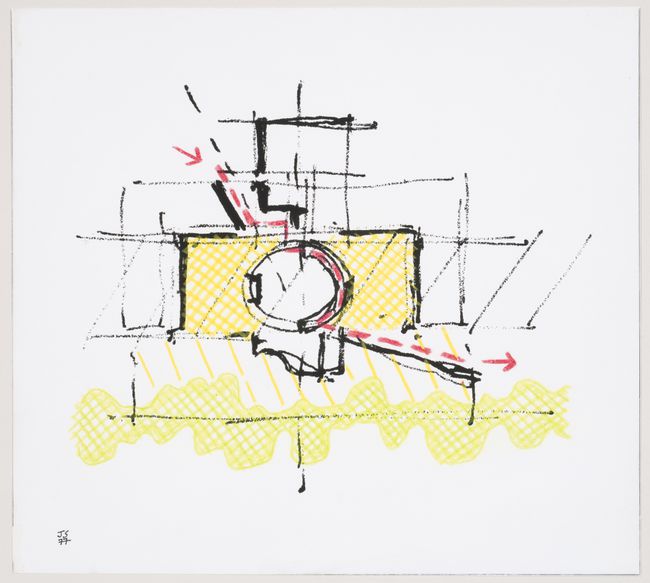In absence of...false starts
Paul Bouet, Christina Shivers, and Thomas Hill on hidden knowledge
This article is the fourth in our “In absence of…” series, authored by the participants of our 2019 Toolkit for Today and introduced by Rafico Ruiz in this primer. In the following, Paul Bouet reflects on the origins of the Trombe Wall, Christina Shivers considers the embodied knowledge within building materials, and Thomas Hill repositions James Frazer Stirling’s Staatsgalerie.
In absence of…colonial origins
Paul Bouet
In the article Douglas Kelbaugh read about the Trombe wall in the October 1973 issue of Architectural Design, the origin of this solar heating technology was not mentioned. Kelbaugh, then a young American architect, didn’t know that the technology he was “falling in love with,” as he would later declare, had been invented in a radically different context than the growing environmental movement of which he was a part.
The Trombe wall had emerged two decades before, on the other side of the Atlantic, out of a technoscientific project led by scientist Félix Trombe. At that time, France was discovering the underground resources of the Sahara, especially oil and natural gas, and trying to exploit them to fuel postwar modernization. In these remote desert territories, with limited access to conventional infrastructures, the direct use of the sun’s energy came to be promoted as the perfect means to power industrial facilities as well as housing units. Invented in Trombe’s laboratory in southern France and tested on a French military base in northern Algeria, the Trombe wall was designed to heat dwellings during the cold desert nights, while a symmetric device could cool them during the day. This technology thus began as a tool to establish colonial settlements for extractive industries located in arid climates.
But after Algeria’s independence in 1962, the Trombe wall’s promoters kept its background silent. Scientists and modernist architects continued to develop this technology in metropolitan France, until the 1973 oil crisis cast a new light on it. Easy to understand and implement, it soon became one of the most popular solar heating devices amongst environmentalists and counterculture activists across the globe. And Kelbaugh contributed to this success: the house he built for his family in Princeton, New Jersey, was celebrated as the first to include a Trombe wall in the United States. Within a decade, it became the most publicized solar house in the country, as the Kelbaugh fonds at the CCA reveals. Through its broad press coverage and numerous applications, the Trombe wall eventually came to embody the promises of solar energy in architecture—the potential of a softer relationship between humans and the environment.
The absence of mention of the Trombe wall’s colonial origin enabled it to acquire a completely different—if not contradictory—meaning in the postcolonial period, and this case is not an isolated one. As scholars such as Jiat-Hwee Chang have shown, the colonization of territories characterized by climates considered “extreme,” in view of western standards, led to the development of architectural technologies of environmental control, which have sometimes been embedded in recent research on “ecological” or “sustainable” design. The trajectories of such technologies are telling not only of these complex and interwoven histories, but also of the very ambivalence of the tools and knowledge we use to master nature.
Recommended readings
• Anker, Peder. From Bauhaus to Ecohouse: A History of Ecological Design. Baton Rouge: Louisiana State University Press, 2010.
• Chang, Jiat-Hwee. A Genealogy of Tropical Architecture: Colonial Networks, Nature, and Technoscience. New York City: Routledge, 2016.
• Winner, Langdon. “Do Artifacts Have Politics?.” Daedalus 109, no. 1 (1980): 121–136.
• Zardini, Mirko and Giovanna Borasi, eds. Sorry, Out of Gas: Architecture’s Response to the 1973 Oil Crisis. Montréal; Mantova: Canadian Centre for Architecture and Corriani Edizioni, 2007.
In absence of…the ingrained
Christina Shivers
The sulphur concrete block—created by McGill University’s Minimum Cost Housing Group (MCHG)—was designed as a scalable, reproducible module for building in Indigenous and rural communities across Canada and Latin America. As its founding mission, the MCHG sought to provide low-cost, environmentally responsible housing, using architectural expertise to identify cheap, free, or readily available materials for building components. The sulphur brick illustrated above was prototyped in a housing experiment in the Saddle Creek Cree Nation in Alberta, Canada, in the 1970s.
While the MCHG’s intentions were commendable, the very notions of reproducibility and scalability disregard the ingrained knowledges of the very communities the MCHG wished to serve. American anthropologist Anna Tsing has criticized the project of modernity for its abstraction of the world into universal conditions and its inability to account for the individuality of place. Indigenous knowledge is localized knowledge: it cannot be rescaled because it is sensitive to its context and it cannot be reproduced because it is specific to a particular materiality, climate, and spirituality. But how does this knowledge fill the gaps in an archive? It cannot travel to the archive when it is tied to the land; rather, objects found in the archive such as this sulphur block should impart on the historian the obligation to travel to the very site of the knowledge they were designed to replace. Only then can archival absences be recovered.
The above story calls into question the very notion of the archive. The “cultural turn” in social anthropology, the “spatial turn” in the social sciences, and the inclusion of anti-positivism, neo-Marxism, and feminist and queer theory into academia have challenged what forms of knowledge are considered credible and why certain sources are cited. Since the 1970s, the inherited dominance of Euro-centric scholarship has repeatedly been unmoored amidst intense criticism from previously silenced voices. This has undoubtedly made the academy stronger, yet why has it taken so long for critical academics to interrogate the very nature of the archive? As historians, scholars, and researchers, we in academia must mobilize missing voices, not speak on their behalf, to assist in a radical project of recovery. Does simply acknowledging these voices give them agency? The postmodern call for a multiplicity of voices is an admirable project, but this must avoid falling into what British social scientist and geographer Doreen Massey called an “apolitical void.” Instead of abandoning radical politics in favour of simply recognizing that absences exist, how can we empower those silenced and absent voices? It is time for academics to listen and let those voices lost and silenced from in and outside of the archive speak.
Recommended readings
• Fannon, Frantz. The Wretched of the Earth. New York City: Grove Press, Inc., 1968.
• Massey, Doreen B. Space, Place, and Gender Cambridge, UK: Polity Press, 1964.
• Tsing, Anna Lowenhaupt. Friction: An Ethnography of Global Connection. Princeton, NJ: Princeton University Press, 2005.
• Tsing, Anna Lowenhaupt. The Mushroom at the End of the World: On the Possibility of Life in Capitalist Ruins. Princeton, NJ: Princeton University Press, 2015.
In absence of…alternatives
Thomas Hill
Since Jacques Derrida’s 1993 book Specters of Marx, it has become fashionable to speak of the “ghosts” of the past—the unrealized ideologies, collective aspirations, and imagined utopias of former epochs—haunting the present moment. Derrida took as pretext Francis Fukuyama’s 1992 book The End of History and the Last Man, to warn that the newly triumphant neoliberal capitalism was doomed to be haunted by the very ideologies it seemed to extinguish. By the end of the first decade of the twenty-first century, Derrida’s “hauntology” had metamorphosed into a coherent cultural critique, one whose adherents sought to uncover in cultural artefacts (above all in architecture) the bygone visions of alternative social orders.
In his 2007 talk introducing the exhibition Utopia’s Ghost: Postmodernism Reconsidered, eventually presented at the CCA in 2008, the architectural historian Reinhold Martin adopts this “hauntological” frame to conduct a survey of postmodernism in architecture. The exhibition sought to foreground the aspirations of high modernism that lay hiding in the major works of postmodernism, works whose designers explicitly rejected their predecessors’ utopian impulses. For Martin—speaking at the precise moment when economic collapse threatened the entire global financial system, if not world capitalism itself—the promise of collective self-realization, so fundamental to modernists, could be read even in the canonical works of postmodernism, whose design appeared to profess allegiance to the 1980s’ crass faith in individualism and the free market. James Stirling’s Neue Staatsgalerie, located in West Germany (an early sketch of which is shown above), reflects, in Martin’s view, a benevolent welfare state as much as it does the democratic path of the capitalist West.
Today, we find ourselves haunted still: this time not just by the specters of Marx, nor by the utopian visions of past cultural movements. As historians of the built environment, we find ourselves haunted by the ghost of a radical aesthetic critique, one which, in the years bracketing 2008, recognized the nullity of Fukuyama’s End of History, the bankruptcy of the neoliberal project, and the potential role for aesthetics in resuscitating the dream of a different—a more communal—social order. “Hauntology” itself proved a fleeting cultural moment: a brief episode whose zenith was the crisis years from 2007 to 2010, when chaos and fear signaled the promise that an alternative to neoliberal supremacy might in fact be possible, if only we could scavenge the scraps of alternative visions hiding in plain sight. The “recovery,” beginning in 2010, has extinguished even that faint promise.
Recommended readings
• Buck-Morss, Susan. Hegel, Haiti, and Universal History. Pittsburgh: University of Pittsburgh Press, 2009.
• Derrida, Jacques. Specters of Marx: The State of the Debt, the Work of Mourning and the New International. New York City; London: Routledge, 1994.
• Fisher, Mark. Capitalist Realism: Is There No Alternative? Winchester, UK: Zero Books, 2009.
• Martin, Reinhold. “Utopia’s Ghost: Postmodernism Revisited.” Lecture, Canadian Centre for Architecture, Montréal, 16 August 2007.
• Martin, Reinhold, curator. Utopia’s Ghost: Postmodernism Reconsidered. Exhibition presented at the Canadian Centre for Architecture, Montréal, 28 February 2008 to 25 May 2008.
• Martin, Reinhold. Utopia’s Ghost: Architecture and Postmodernism, Again. Minneapolis; London: University of Minnesota Press, 2010.
• Mirowsky, Phillip. Never Let a Serious Crisis Go to Waste: How Neoliberalism Survived the Financial Crisis. London; New York City: Verso, 2013.



